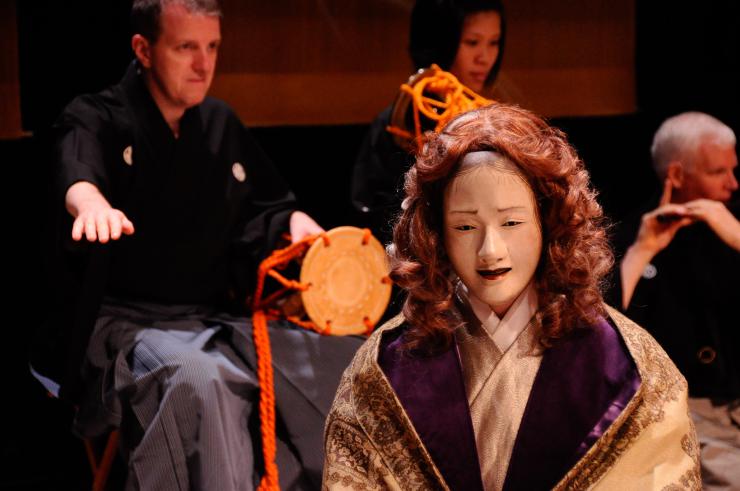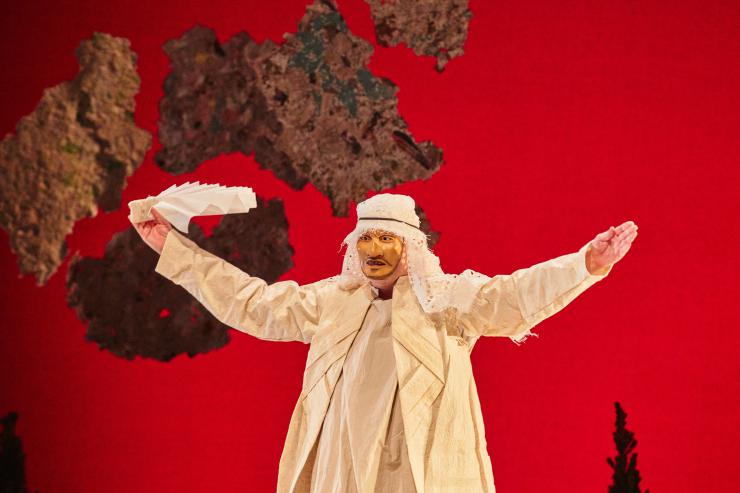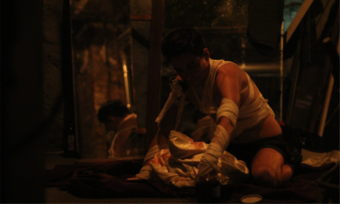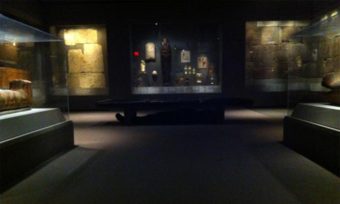Zahdi Dates and Poppies
Noh Drama at Boston University
Theatre Nohgaku (TN) is an international performance group dedicated to sharing the beauty and power of the classical Japanese noh drama with English speaking audiences and performers. In March, TN was in residence at Boston University through the BU Arts Initiative, during which they presented the world premiere of Zahdi Dates and Poppies written by Carrie Preston. Ty Furman interviewed the artists involved in the residency, asking them to talk about noh theatre, the creation of new work influenced by noh, and questions of cultural appropriation and transnational artistic exchange.
The artists are:
David Crandall: TN company member, performer, composer for Zahdi Dates and Poppies
Jubilith Moore: TN company member, director for Zahdi Dates and Poppies
Carrie Preston: Writer and co-choreographer of Zahdi Dates and Poppies
Richard Emmert: Artistic director of TN, director/translator/arranger/actor – Sumida River, and chorus for Zahdi Dates and Poppies
Hideta Kitazawa: Woodcarving artist, designed masks for Zahdi Dates and Poppies

What is noh theatre?
Hideta: Noh is a theatre form that keenly and straightforwardly strikes at the heart of what it is to be human.
Carrie: You could define noh by performance elements, as a musical dance theatre including masks and elaborate costumes, but there are many forms of theatre that might be described this way. A definition by performance elements doesn’t actually tell us much about noh’s specificity or power. Many definitions focus on noh’s aesthetic, typically discussing the austere, mysterious beauty called yūgen.
David: I have found noh to be impossible to define, but some characteristics that stand out for me are concentration, inward stillness, and a focus on our shared humanity as a species, which goes deeper than personality.
Richard: Noh is like opera. If you take a Mozart opera text and present it as a dialogue drama, is it still opera? I don’t think so. An opera needs to be sung in an “operatic” style. Noh needs to be sung and performed movement-wise in a “noh” style.
Theatre Nohgaku’s work has invoked terms such as “English noh,” “fusion theatre,” and “transnational theatre.” Do you feel that these or other terms describe your enterprise?
Hideta: Traditional noh uses Japanese language from five hundred years ago, which is hard for us modern Japanese to understand just by hearing it. Sometimes, it’s actually easier for me to understand a noh when it’s performed in English.
Carrie: To me, “English noh” does not seem particularly useful as it suggests that noh is this thing that could simply be translated into one language or another. I don’t believe that to be the case.
Richard: “English noh” refers to plays in the English language that are performed using the music and movement stylization that is typical of noh.
David: I’m not very concerned with labels. My main interest is in creating pieces that people will find moving and meaningful.
Richard: I have been involved in a variety of plays that are collaborative works which feature performers trained in and using noh elements performing with performers of other genres. I would call those “collaborative theatre.” Perhaps others might call that fusion theatre.
Carrie: “Fusion” always reminds me of food and bombs. I think the term “transnational” is helpful as it characterizes art forms that travel across national bounds and demonstrate both affiliations and specificities in the process.

How did you personally become interested in noh?
Jubilith: I auditioned for Yuriko Doi in 1993 and was cast in Drifting Fires, a noh in English by Janine Beichman. I had never heard of noh prior to this. While we did not perform the play traditionally, it was during this first experience I started reading the writings of Richard Emmert and learning about the form. I have always liked the lexicon of noh; the way it felt in my body; the mask work; its insistence upon skill and understated celebration of virtuosity. From the very beginning it felt like a good fit for me.
Carrie: I first became interested in noh when I was doing research for my forthcoming book, Learning to Kneel. I decided that in order to write a book about how the transnational circulation of noh (and misunderstandings about noh) influenced modernism, I would need to take lessons in noh performance technique and learn as much as I could about the form.
David: I studied Japanese literature and music composition as an undergrad at the University of Michigan and started training in noh in 1979 as a graduate student at the Tokyo University of Fine Arts and Music. I had twelve years of intensive training that included an apprenticeship from 1986 to 1991, during which time I worked backstage and performed as a professional.
Richard: I was introduced to noh when I was in college in a seminar by a theatre professor and a music professor at Earlham College in Indiana. Both had spent time in Japan and had become interested in noh. Later, in Japan, I was interested in studying Japanese traditional music and when I met a noh actor, I decided to study that as well. Though I did not intend to stay in Japan, the more I studied, the more I wished to expand my study. Rather than specifically choosing to do noh, I feel that noh chose me.
What does it mean for you to be a non-Japanese actor/director/composer/writer approaching noh material?
Jubilith: As an outsider, I'm very aware that my experience is dramatically different than those on the inside, and I try and see that as the opportunity I believe it to be, while being respectful, mindful, and polite. Even in my irreverence, I wish to be reverent.
David: I am the first (and to my knowledge still the only) non-Japanese to undergo a traditional training regimen in the Hōshō school of noh, which is one of five professional schools. I was always treated with tremendous courtesy, kindness, and respect, and though there wasn’t really a comfortable place for me within the traditional hierarchy, it was never my goal to pursue a career as a noh actor. I always approached my training from the perspective of a writer/composer with the intention of creating new work.
Carrie: For me as a non-Japanese writer and researcher approaching noh, I need to tread very carefully, with tremendous humility. I need to learn as much as I can but also never claim an expertise I don’t have. At the same time, I want to take advantage of and share the creative possibilities that noh offers.
Jubilith: It deeply hurts me that I have performed for a paying audience on the stage of the Kita Nohgakudo and my teacher, Kinue Oshima, the only acknowledged woman performer of the Kita school has not. I am immensely honored and grateful for that opportunity and simultaneously ashamed that I didn't have the where-with-all and power to boycott and make a stand for women in noh.
Noh’s simple structure supports and in fact embraces the complexity of the human experience and is a natural delivery system for multiple messages on multiple levels simultaneously.
Do you consider Zahdi Dates and Poppies a noh play?
Jubilith: I would call Zahdi Dates and Poppies a modern noh play, one among many in the constellation of plays written by Western poets and playwrights after being introduced to noh. The form of noh is attractive to wordsmiths because it enables them to suggest, in a very succinct whole, a poetic and complicated story. Its simple structure supports and in fact embraces the complexity of the human experience and is a natural delivery system for multiple messages on multiple levels simultaneously.
Carrie: Zahdi is inspired by noh and adapts some of the form’s conventions, but I don’t consider it noh. I was searching for a way to face my husband’s deployment as a jet pilot in Iraq, particularly to face the lives he took there. The noh warrior play often features the ghosts of defeated warriors, and it offered me a helpful form and structure, but also one that proved too binding for my story.
Richard: The musical score uses some elements not typical to noh, but TN’s approach is very noh-like and so I would call it a noh. The text itself does not make it noh. Rather, like opera, it is the style of performance which makes it noh.
Jubilith: If the play isn’t noh, that’s not because Preston didn’t understand noh, but because she fully embraced and honored her own rigorous creative process. Her goal was not to write a noh in English, but to generate an artistic gesture capable of containing her complicated and emotionally charged story.
How did you approach the noh elements and nontraditional elements of the play when you were creating Zahdi?
Jubilith: We staged the work utilizing a traditional noh inspired physical vocabulary. However, the production does contain nontraditional elements, some written into the score and some organically discovered in the rehearsal room.
David: It would have been possible for me to set the entire piece without straying from traditional practice. But I wanted to introduce other elements, in particular more Western-style melodies and even harmony, to create a kind of spectrum that ranged from pure noh chant on one end to the kind of vocal production we associate with Western singing on the other.
Jubilith: It is easy to say that the instrumentation is traditional and the harmonies are not, but I struggle with this sort of black and white dissection.
Hideta: Our first step was for Jubilith to find traditional masks that could provide the basic concept for the mask we wanted to create. Jubilith also provided me with photos of Middle Eastern men that matched her image of what the mask should look like and gave me information about the story, the various roles in the play, and the costumes. Based on that information I drew sketches and made a clay model, which provided the basis for further discussion.
Carrie: In my first drafts I forced myself to stick very closely to noh structures, even counting the syllables that should go in each line. In later revisions, I relaxed that structure and allowed the story and the poetry to dictate the form.

What were the biggest challenges for you in your work on Zahdi? Successes?
Carrie: My biggest challenge was not as a writer but as a co-choreographer of the piece, when I ran headlong into the question of how closely we would stick to noh traditions in staging and movement patterns. I thought we should follow only the rules that work for our play. I was encouraging the company to abandon conventions in the staging, and that wasn’t always comfortable for the rest of the creative team or performers who have devoted themselves to noh training.
Jubilith: We [TN], as a company dedicated to developing noh in English without a lot of resources, took the path we could, the path we knew when developing this work. While I believe this may be a challenge to realizing the play, TN’s immensely talented company members and ability to work quickly inside the given medium of noh is one of the major successes of this production.
David: My biggest challenge was to meld the disparate elements, from traditional noh music to Western singing, into a single sonic world that feels integrated.
Hideta: The most difficult challenge in creating the mask was to achieve the look of a Middle Eastern man while retaining a traditional noh mask’s ability to change expression depending on its upward/downward angle. If that atmosphere is conveyed to the audience when the mask is actually used on stage, I’ll consider it a success.
The insular alternatives, such as building walls around our cultural traditions and refusing to learn about those of others, are worse than the dangers of misunderstanding or the accusations of appropriation.
Many western artists became fascinated by noh after the first English translations began to circulate at the end of the nineteenth century, and several even tried to write plays modeled on noh (W. B. Yeats, Ezra Pound, Bertolt Brecht, etc.) That work has been criticized as a form of cultural appropriation. Have you had to respond to such accusations?
Carrie: I understand cultural exchange and misunderstanding as an inevitable and necessary phenomenon. We must be careful, but the insular alternatives, such as building walls around our cultural traditions and refusing to learn about those of others, are worse than the dangers of misunderstanding or the accusations of appropriation.
David: I don’t think what we do is any more a case of cultural appropriation than, say, an American who has earned a black belt in karate. Noh is all about training. If you have the training, you are a noh practitioner, regardless of your background.
Richard: Having trained entirely in Japan and performed with performers in Japan, I have never sensed that Japanese performers consider what I do as an appropriation. If anything, performers consider it a compliment.
Hideta: I don’t think that accusations of cultural appropriation apply. Noh brings spirits and the ghosts of the dead to the stage. Although its stories can be a bit improbable, noh is a superb performance art capable of beautiful expression through stylized dance and music. I think that TN’s use of noh to create new works and perform traditional pieces in English is deeply meaningful.
Theatre Nohgaku’s presentation of Zahdi Dates and Poppies and related lectures on noh theatre delivered at Boston University March 25 and 26, 2016, were livestreamed on HowlRoundTV. This interciew was edited by Ty Furman and Carrie Preston.







Comments
The article is just the start of the conversation—we want to know what you think about this subject, too! HowlRound is a space for knowledge-sharing, and we welcome spirited, thoughtful, and on-topic dialogue. Find our full comments policy here
I am continually amazed by the amount of information available on this subject.What you presented was well researched and well worded in order to get your stand on this across to all your readers <a href="https://howlround.com/%3Ca%20href%3D"https://japaneseonimasks.com/">https://japaneseonimasks.com/"> japanese oni masks </a>.